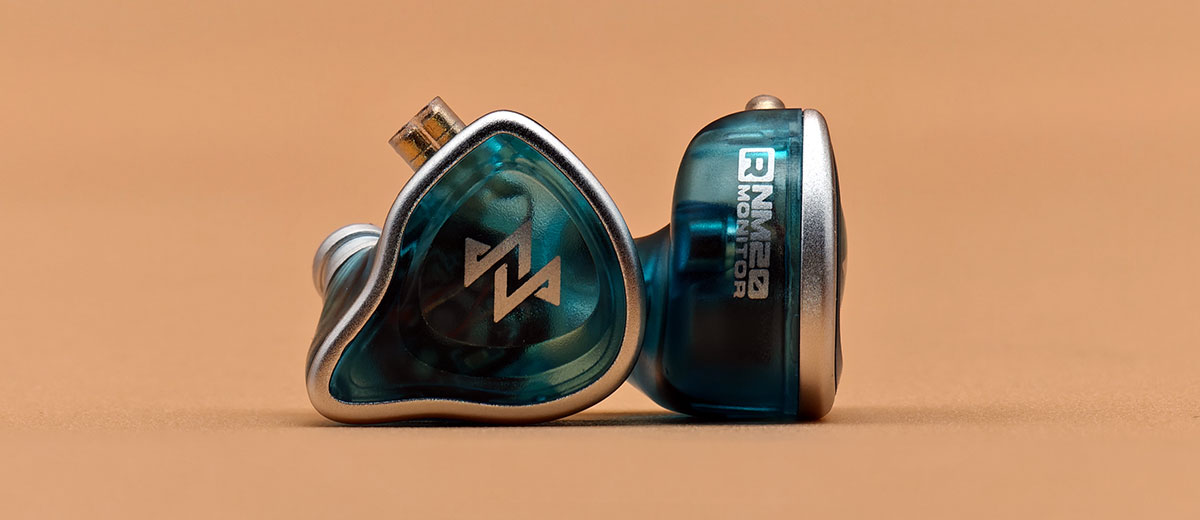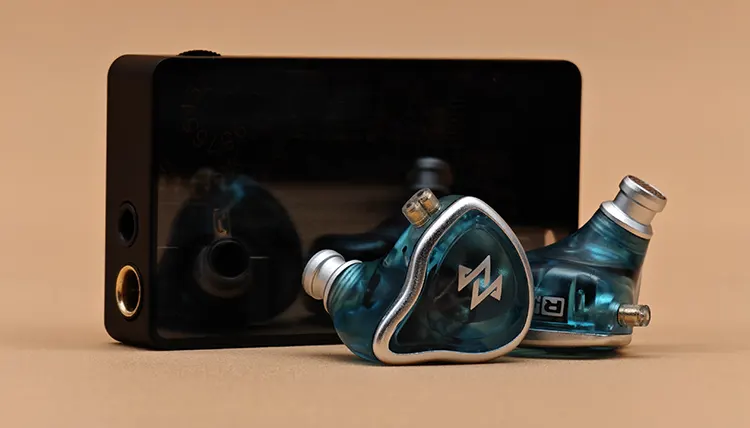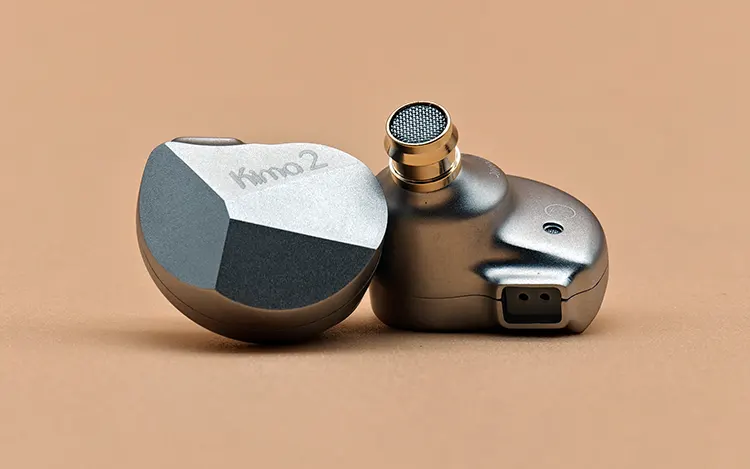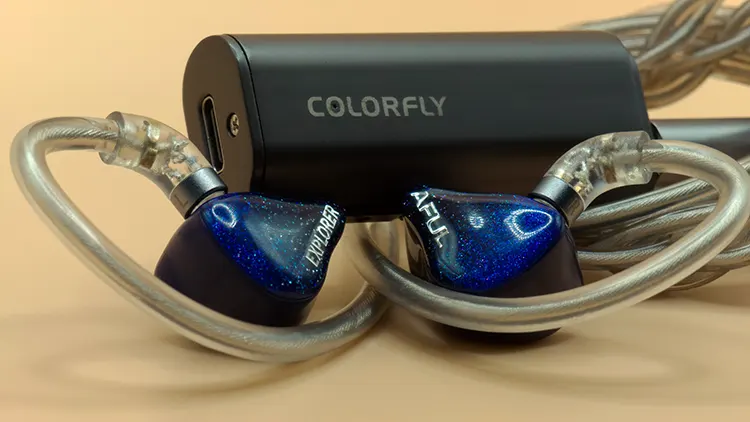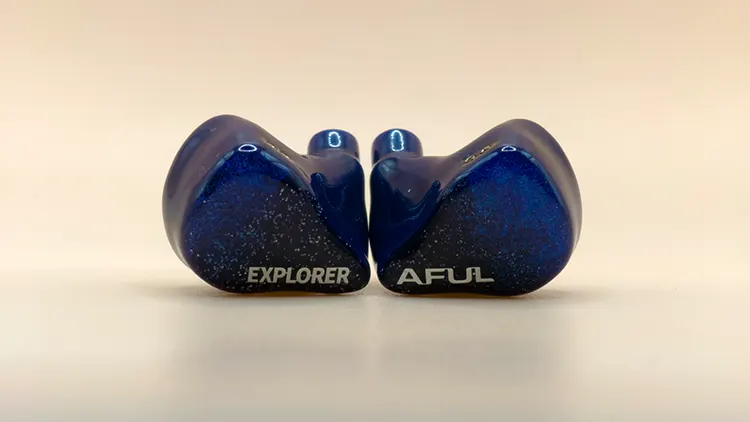Synergy
Efficiency
The NF ACOUS NM20 has a sensitivity of 108 dB/mW and an impedance of 32Ω, making it easy to drive with most devices. You won’t need a powerful amp or DAP to get decent volume levels from these IEMs.
At lower volumes, the bass loses some of its presence, and both the midrange and treble become slightly weakened. However, the breathiness in vocals remains noticeable, which can be distracting during quieter listening sessions, since it sounds like a type of whisper singing.
When you turn up the volume, the bass returns with its audible rumble, bringing more energy to the lower end. Unfortunately, this also brings back the sibilance in the treble, and the mids and highs start to compete for attention again, leading to a weaker separation of sound.
Balanced terminations aren’t necessary to enjoy the NM20, as its standard 3.5mm connection works well with a variety of sources. However, the added 6.35mm adapter is here for stage performers or those who do audio mixing.
Pairings
The NF ACOUS NM20 performs reliably when paired with an Android phone through a 3.5mm jack. It’s easy to drive, maintains its original sound signature, and doesn’t introduce any unwanted coloration or distortion.
With the Colorfly CDA-M2, the NM20 shows a noticeable improvement in clarity and detail. The mids and treble gain more definition, while the bass stays controlled and textured, making it an enjoyable pairing for critical listening.
Switching to the HeartField R1 brings a surprising transformation to the NM20’s sound signature. The sibilance, breathiness, and sharpness in the treble get tamed, while the bass becomes fuller and more present.
However, even with the R1’s refinement, the midrange remains recessed behind the bass and treble. Despite this, the overall balance feels more natural and engaging compared to the other pairings.
Select Comparisons
DUNU KIMA 2
Technical
The DUNU KIMA 2 features a next-generation DLC composite dome diaphragm dynamic driver, engineered for precise and clean sound reproduction.
This driver delivers clarity and responsiveness, resulting in a refined and polished audio presentation.
To ensure tonal balance, the KIMA 2 incorporates a dual-cavity acoustic structure that minimizes unwanted resonance.
Combined with a high magnetic flux circuit system, the design enhances driver efficiency, reduces distortion, and maintains smoother sound transitions.
Tuned with DUNU’s VERNUS Sound Mastery Curve, the KIMA 2 focuses on a balanced and rich sound signature. Strategic dampening materials further optimize the performance, ensuring a natural presentation across a variety of musical genres.
Design
The DUNU KIMA 2 brings a sleek and modern design with its sharp geometric lines and brushed metallic finish. It manages to look refined without feeling overly flashy, and its compact shell fits comfortably without adding unnecessary bulk.
Subtle details like the gold-finished nozzle and the small hump underneath help ensure a secure fit. Branding is kept clean with “KIMA 2” and “Criz Faction” etched onto the shell, giving it a polished and professional look.
The angular edges of the shell give it a bold visual character but are shaped carefully to avoid discomfort during long listening sessions.
It comes in two main color options with a clean white matte finish for a subtle look and an emerald, green variant for something a bit more eye-catching.
Performance
The NF ACOUS NM20 pulls ahead in the sub-bass, delivering a more noticeable rumble compared to the DUNU KIMA 2. Midbass follows suit, staying clean and controlled, while the KIMA 2 struggles with some bass bleed into the mids.
In the midrange, the KIMA 2 takes a clear lead with its lush and natural-sounding vocals. The NM20, on the other hand, leans into sharpness and breathiness, making vocals feel less grounded and overly airy.
Vocals on the DUNU KIMA 2 sit more forward in the mix, giving them a natural and intimate presence. On the other hand, the NF ACOUS NM20 places vocals further back, where they often get drowned out by the bass and treble.
This makes the NM20’s vocals feel distant and disconnected from the experience. There’s also a sense that they’re struggling to break through like they’re hitting a wall and can’t quite reach their full potential.
While the KIMA 2 shines in timbre and note weight, it isn’t perfect, with its mids occasionally sounding a bit muddy. Still, its intimate presentation feels more personal and engaging compared to the NM20.
Instruments have more lifelike energy on the KIMA 2, while the NM20 struggles with thinness and a lack of texture in its mids. However, the NM20 counters with better detail retrieval, pulling out small nuances that the KIMA 2 tends to gloss over.
Sibilance is where the NM20 stumbles hard, becoming sharp and fatiguing over time. The KIMA 2 avoids this pitfall entirely, offering a smooth treble response that feels easygoing even during long listening sessions.
Lastly, the NM20 pulls ahead again with a wider soundstage and more precise imaging. The KIMA 2 feels more intimate and slightly limited in how it places sounds within its stage.
AFUL Explorer
Technical
The AFUL Explorer features a 1DD + 2BA driver configuration, with each driver specifically tuned to handle different frequency ranges.
The dynamic driver takes charge of the bass, while one balanced armature focuses on the mids and the other manages the treble.
The balanced armatures use an aluminum-magnesium alloy diaphragm, improving the control and clarity of higher frequencies. AFUL also implements a multi-layered crossover system to ensure seamless driver integration and reduce any unwanted distortion.
To enhance overall comfort and reduce ear fatigue, the Explorer incorporates an air pressure balancing system.
This thoughtful engineering contributes to a smoother bass response and a more refined listening experience across different music genres.
Design
The AFUL Explorer presents a striking faceplate design with a glitter-filled starry night aesthetic, blending shades of blue and black. Subtle branding elements, including the “Explorer” and “AFUL” labels, are printed cleanly on the surface.
Its shell maintains a seamless transition from the faceplate, carrying over the darker blue hues. The acrylic material provides a smooth finish, giving the IEM both a polished look and a comfortable feel during extended use.
A single vent near the nozzle handles airflow, contributing to pressure relief and acoustic performance. This approach, combined with AFUL’s dampening technology, ensures minimal resonance and a well-controlled sound presentation.
Performance
When it comes to bass, the AFUL Explorer takes a clear lead with both sub-bass and midbass offering better texture, depth, and impact. The NF ACOUS NM20, while capable of delivering a decent sub-bass rumble, feels lighter and less authoritative in comparison.
The Explorer pushes closer to a basshead experience without introducing any bass bleed into the mids. The NM20 struggles to keep up here, delivering an acceptable low-end but lacking the same level of control and punch.
In the midrange, the Explorer pulls ahead again with a thicker note weight and a more natural timbre. Both IEMs keep vocals positioned slightly recessed, but the Explorer handles them with more warmth and fullness, while the NM20 leans leaner and sharper.
The NM20 does have an edge when it comes to vocal clarity and forwardness, but it comes with a trade-off. Its brightness adds an unnatural sharpness that can turn fatiguing over time, while the Explorer remains smooth and controlled.
Treble is where the NM20 makes a stronger case for itself. Detail retrieval and overall sparkle are more pronounced, making smaller nuances in tracks easier to pick out compared to the Explorer.
However, this strength is also its weakness. The NM20’s treble often pushes into sibilance, creating fatigue during longer listening sessions, while the Explorer maintains a more relaxed treble presentation.
In staging and imaging, the NM20 has a slight edge in width, creating a more expansive soundstage. The Explorer, however, wins in imaging precision, placing instruments and vocals more accurately within the stage.
My Verdict
The NF ACOUS NM20 single dynamic driver IEM excels in technical performance, delivering good detail retrieval, expansive soundstage, and precise imaging.
Its sub-bass rumble and detailed treble provide an engaging listening experience that captures intricate nuances in tracks.
With its clean presentation and sharp clarity, the NM20 seems well-suited for stage performers or musicians who rely on accuracy and separation in their monitoring.
It delivers a focused sound signature that highlights critical details, making it a reliable choice for professional use.
NF ACOUS NM20 Technical Specifications
- Driver Type: One (1x) 10mm MC2L-100P Dynamic Driver
- Plug: 3.5mm Termination with 6.35mm Adapter
- Frequency Response: 9Hz – 40kHz
- Impedance: 32Ωs @ 1kHz
- Sensitivity: 108 dB/mW

